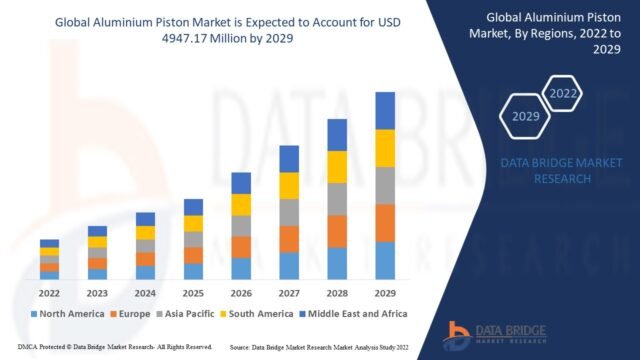Introduction
The aluminium piston market plays a pivotal role in the automotive and industrial sectors, serving as a cornerstone for internal combustion engines (ICEs) and various industrial applications. Aluminium pistons are essential components in engines, converting the energy from fuel combustion into mechanical motion to power vehicles and machinery. Consequently, their demand is closely tied to the automotive industry’s growth, industrial advancements, and evolving technological trends. Furthermore, aluminium’s lightweight, durable, and heat-resistant properties make it a preferred material for pistons, especially in a world increasingly focused on fuel efficiency and performance. This guest post explores the aluminium piston market in depth, covering its evolution, current trends, challenges, scope, size, and factors driving its growth. By examining these aspects, we aim to provide a comprehensive understanding of this dynamic market and its future trajectory.
Source: https://www.databridgemarketresearch.com/reports/global-aluminium-piston-market
The Evolution
The journey of aluminium pistons began in the early 20th century, when internal combustion engines started gaining prominence in automobiles. Initially, pistons were primarily made from cast iron due to its strength and availability. However, as automotive technology advanced, the need for lighter materials became apparent. Consequently, aluminium emerged as a game-changer, offering a superior strength-to-weight ratio. By the 1920s, aluminium pistons started appearing in high-performance vehicles, particularly in racing cars, where reduced weight translated to better speed and efficiency.
Over the decades, manufacturing techniques evolved significantly. For instance, early aluminium pistons were cast, but advancements in forging techniques in the mid-20th century allowed for stronger, more precise components. Moreover, the introduction of alloying elements like silicon, magnesium, and copper enhanced aluminium pistons’ durability and heat resistance. As a result, by the late 20th century, aluminium alloy pistons became the standard for most passenger vehicles.
Additionally, the rise of computer-aided design (CAD) and precision machining in the 1980s and 1990s further revolutionized piston production. These technologies enabled manufacturers to create complex piston designs tailored to specific engine requirements. Meanwhile, the growing emphasis on fuel efficiency and emissions reduction in the 2000s spurred innovations like thermal barrier coatings and friction-reducing surfaces. Today, aluminium pistons are not only lighter and stronger but also optimized for high-performance and eco-friendly engines. This evolution reflects the industry’s adaptability to changing technological and environmental demands.
Market Trends
The aluminium piston market is shaped by several key trends that reflect broader shifts in the automotive and industrial sectors. First and foremost, the push for fuel efficiency is a major driver. As governments worldwide impose stricter emission regulations, automakers are downsizing engines and adopting turbocharging technologies. Consequently, aluminium pistons, with their lightweight properties, are in high demand to reduce engine weight and improve fuel economy.
Another significant trend is the integration of advanced manufacturing techniques. For example, 3D printing has emerged as a transformative technology, allowing manufacturers to produce high-performance pistons with intricate designs. Similarly, the use of advanced coatings, such as thermal barriers and oil-shedding layers, enhances piston durability and efficiency. These innovations enable pistons to withstand higher temperatures and pressures, which is critical for modern turbocharged engines.
Furthermore, the rise of hybrid vehicles is influencing the market. While electric vehicles (EVs) rely on battery-powered systems, hybrid vehicles combine internal combustion engines with electric motors, maintaining the need for high-quality pistons. As a result, manufacturers are developing aluminium pistons specifically designed for hybrid engines, balancing performance with lightweight construction.
Moreover, sustainability is becoming a focal point. Manufacturers are increasingly adopting eco-friendly production processes, such as using recycled aluminium and reducing energy consumption during manufacturing. This trend aligns with global efforts to minimize the environmental impact of industrial activities. Additionally, the aftermarket segment is gaining traction, as vehicle owners seek high-performance replacement pistons for maintenance and tuning purposes.
Finally, regional market dynamics are shaping trends. For instance, Asia-Pacific, particularly China and India, is witnessing rapid growth in piston demand due to booming automotive production. Meanwhile, North America and Europe focus on innovation, with companies investing heavily in research and development (R&D) to create next-generation pistons. These trends collectively highlight the aluminium piston market’s adaptability to technological, environmental, and regional shifts.
Challenges
Despite its growth, the aluminium piston market faces several challenges that could impact its trajectory. First, the rise of electric vehicles poses a significant threat. Since EVs do not use internal combustion engines, widespread adoption could reduce demand for traditional pistons. Consequently, manufacturers must diversify their offerings or adapt to new powertrain technologies, such as those used in hybrid vehicles.
Additionally, raw material price volatility is a concern. Aluminium prices fluctuate due to supply chain disruptions, geopolitical factors, and demand from other industries, such as construction and aerospace. As a result, manufacturers face challenges in maintaining cost competitiveness while ensuring high-quality production. Moreover, the energy-intensive nature of aluminium production adds to costs, particularly in regions with high energy prices.
Another challenge is the increasing complexity of engine designs. Modern engines, with features like turbocharging and direct injection, place higher thermal and mechanical stresses on pistons. Therefore, manufacturers must invest in advanced materials and coatings to meet these demands, which can increase production costs. Furthermore, stringent emission regulations require continuous innovation, adding pressure to R&D budgets.
Supply chain disruptions also pose a risk. For example, recent global events, such as pandemics and trade restrictions, have highlighted vulnerabilities in sourcing raw materials and components. Consequently, manufacturers must build resilient supply chains to ensure consistent production. Additionally, competition from alternative materials, such as composites and forged steel, challenges aluminium’s dominance in certain high-performance applications.
Lastly, the market faces intense competition, particularly in emerging economies where low-cost manufacturers are gaining market share. As a result, established players must balance cost, quality, and innovation to maintain their competitive edge. These challenges underscore the need for strategic planning and adaptability in the aluminium piston market.
Market Scope
The scope of the aluminium piston market is vast, encompassing a wide range of applications and industries. Primarily, the automotive sector drives demand, with aluminium pistons used in passenger cars, commercial vehicles, motorcycles, and high-performance vehicles. Additionally, the market serves industrial applications, including pumps, compressors, and cylinders used in construction, agriculture, and power generation.
Geographically, the market spans multiple regions, with Asia-Pacific leading due to its robust automotive manufacturing base. Countries like China, India, and Japan account for a significant share of global piston production, driven by rising vehicle ownership and industrialization. Meanwhile, North America and Europe remain key markets, focusing on advanced piston technologies for high-performance and eco-friendly engines.
The market also includes both original equipment manufacturers (OEMs) and the aftermarket. OEMs dominate due to large-scale vehicle production, while the aftermarket caters to vehicle maintenance, repair, and performance upgrades. Furthermore, the market is segmented by alloy type (e.g., Aluminium 2618, Aluminium 4032), coating type (e.g., thermal barriers, dry film lubricants), and manufacturing process (e.g., cast, forged). These segments allow manufacturers to target specific applications and performance requirements.
Moreover, the market’s scope extends to emerging technologies, such as pistons for hybrid vehicles and hydrogen-powered engines. As the automotive industry evolves, the aluminium piston market is poised to adapt, offering opportunities for innovation and growth across diverse applications and regions.
Market Size
The aluminium piston market has experienced steady growth, driven by rising vehicle production and technological advancements. In 2023, the global automotive piston market was valued at approximately USD 2.9 billion, with aluminium pistons accounting for a significant share due to their widespread use in passenger vehicles. By 2028, the aluminium piston market is projected to reach USD 4.51 billion, growing at a compound annual growth rate (CAGR) of 3.7%.
Regionally, Asia-Pacific holds the largest market share, contributing over 55% of global piston production. China alone produced over 350 million pistons in 2024, driven by its massive automotive industry. North America and Europe follow, with strong demand for high-performance and lightweight pistons. The Middle East and Africa, while smaller markets, are seeing growth due to industrial applications in construction and power generation.
By vehicle type, passenger cars dominate, accounting for 60-65% of piston demand in 2024. Commercial vehicles, including trucks and buses, also contribute significantly, particularly in regions with strong logistics and construction sectors. Additionally, the aftermarket segment is growing, driven by the need for replacement pistons in aging vehicles and performance tuning.
The market’s growth is supported by the increasing production of gasoline and diesel vehicles, which rely heavily on aluminium pistons. However, the shift toward electrification introduces uncertainty, as electric vehicles do not require traditional pistons. Nevertheless, the continued relevance of internal combustion engines in hybrid vehicles and emerging markets ensures steady demand for aluminium pistons in the near term.
Factors Driving Growth
Several factors are propelling the aluminium piston market forward. First and foremost, rising vehicle production is a key driver. Global passenger car production increased from 62.8 million units in 2021 to 69.2 million units in 2023, boosting demand for pistons. This growth is particularly pronounced in emerging markets like China and India, where rising disposable incomes and urbanization are driving vehicle ownership.
Secondly, the demand for fuel-efficient vehicles is a major catalyst. Aluminium pistons’ lightweight properties reduce engine weight, improving fuel economy and reducing emissions. As a result, automakers are increasingly adopting aluminium alloys to meet stringent emission regulations. For example, over 70% of pistons in internal combustion engines in 2023 were made from aluminium alloys, reflecting their dominance in the market.
Thirdly, technological advancements are fueling growth. Innovations like 3D printing, advanced coatings, and lightweight alloys enhance piston performance, making them suitable for modern engines. For instance, thermal barrier coatings improve heat resistance, while friction-reducing coatings extend piston lifespan. Additionally, partnerships between manufacturers and technology firms are driving the development of next-generation pistons.
Moreover, the growing popularity of high-performance vehicles and motorcycles is increasing demand for aluminium pistons. High-end bikes and sports cars require lightweight, durable components to achieve superior performance, making aluminium the material of choice. Similarly, the aftermarket segment is thriving, as enthusiasts invest in high-performance pistons for vehicle upgrades.
Finally, government initiatives and infrastructure development in emerging economies are boosting industrial applications. For example, construction and power generation sectors in the Middle East and Africa are driving demand for pistons in heavy machinery. These factors collectively create a robust growth environment for the aluminium piston market.
Conclusion
In conclusion, the aluminium piston market is a dynamic and evolving sector, driven by technological advancements, rising vehicle production, and the push for fuel efficiency. While challenges like the rise of electric vehicles and raw material price volatility exist, the market’s scope remains broad, encompassing automotive, industrial, and aftermarket applications. Furthermore, regional dynamics, particularly in Asia-Pacific, North America, and Europe, highlight the market’s global reach. With a projected market size of USD 4.51 billion by 2028, the aluminium piston market is poised for steady growth, fueled by innovation and demand for high-performance, eco-friendly engines. As the industry adapts to emerging trends and challenges, aluminium pistons will continue to play a critical role in powering the vehicles and machinery of the future.




